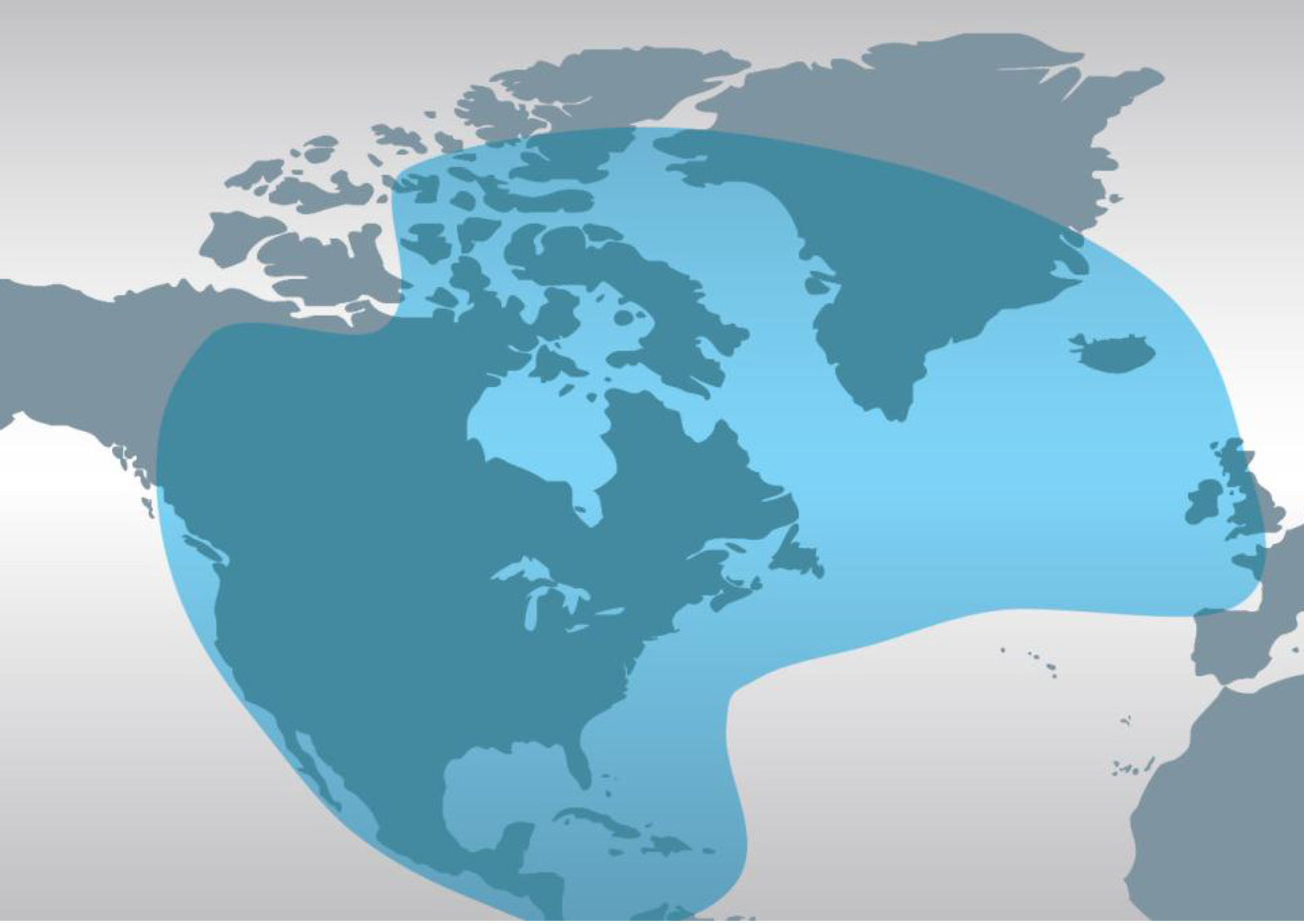
PARIS — Satellite broadband services and hardware provider ViaSat Inc. on May 16 announced that its $625 million ViaSat-2 Ka-band satellite system will use a Boeing-built satellite employing a design that has never been seen before.
In a conference call with investors, ViaSat Chief Executive Mark D. Dankberg said ViaSat-2, to be launched in mid-2016, will not just be a more powerful version of the 140-gigabit-per-second ViaSat-1, which is ViaSat’s principal source of consumer satellite broadband revenue.
In addition to a much broader coverage area including the Atlantic Ocean between North America and Europe, and a capacity that ViaSat said will be equivalent to 2.5 times ViaSat-1, the new satellite apparently does away with the classic Ka-band spot-beam design.
“This is not a steerable-beam, spot-beam satellite that offers service anywhere” in its coverage area, Dankberg said. “Ours is an everywhere satellite that offers an orders-of-magnitude improvement” over existing designs. “It’s the first of its kind in terms of capacity and geographic coverage. It’s just never been done before.”
El Segundo, Calif.-based Boeing Space & Intelligence Systems will be using its 702HP as the ViaSat-2 satellite platform. Boeing will also be partnering with Carlsbad, Calif.-based ViaSat in selling ViaSat-2 look-alikes to other markets, using both Boeing-proprietary and ViaSat-proprietary technology, Dankberg said.
While declining to give details of the satellite’s on-board power, beam configuration and other specifics, Dankberg did provide several details of the ViaSat-2 system during the conference call. Among them:
- ViaSat-2 system costs — including the satellite, its launch, launch insurance and a dedicated ground infrastructure — will be 25 percent more than ViaSat-1, or about $625 million.
Most of the additional cost will be in the Boeing satellite procurement. The launch cost is expected to be similar to ViaSat-1, as ViaSat-2 will not weigh much more than the 6,740-kilogram ViaSat-1. Insurance costs have not increased, although the premium ViaSat will pay will depend in part on the total dollar amount it seeks in insurance, and the amount of untested technology on the satellite. The satellite itself will cost about 40 percent more than ViaSat-1, Dankberg said.
- ViaSat-2 will cover all of North America, Central America and the Caribbean, with coverage including the U.S. East Coast seaboard commercial air routes and the main air and maritime routes between North America and Europe. The coverage area is seven times the size of ViaSat-1’s coverage.
- Because of its radically different design, ViaSat-2’s throughput is not easily measured in gigabits per second. Dankberg said that it would offer 2.5 times the capacity of ViaSat-1 in the sense that it can serve 2.5 million customers at today’s ViaSat Exede 12 service level, or the same 1 million customers that ViaSat-1 can support at 2.5 times the bandwidth.
ViaSat’s high-end Exede 12 commercial service offers customers a 12-megabit-per-second downlink, a 3-megabit uplink and a metered usage ceiling between 5 a.m. and midnight of 12, 15 or 25 gigabytes per month for $49.99, $79.99 and $129.99 in monthly subscription costs, respectively.
Neither ViaSat nor Boeing released detailed artists’ conceptions of ViaSat-2, a measure of ViaSat’s opinion of the satellite’s novelty. It is also perhaps a consequence of ViaSat’s ongoing patent infringement lawsuit against the builder of ViaSat-1, Space Systems/Loral of Palo Alto, Calif.
In the conference call, Dankberg evoked the Loral lawsuit on several occasions. Space Systems/Loral and its former parent company, Loral Space and Communications of New York, have countersued, alleging patent infringement violations by ViaSat. ViaSat is seeking an injunction against further alleged patent infringements, although it remains unclear how this threat will affect Space Systems/Loral’s commercial activities.
Space Systems/Loral, which since the ViaSat lawsuit has been sold to MDA Corp. of Canada, has sold other high-throughput Ka-band broadband satellites, most recently a 160-plus gigabit-per-second Jupiter 2/EchoStar 19 consumer Ka-band broadband satellite to ViaSat rival EchoStar/Hughes.
Loral has rejected ViaSat’s allegations, saying ViaSat is claiming credit for technology developments that were well understood before ViaSat adopted them.
ViaSat said its Exede consumer broadband service had 512,000 subscribers as of March 31, the end of the company’s 2013 fiscal year, which is a 33 percent increase from the same period a year ago.
The cost of securing each new subscriber remains at between $700 and $800. ViaSat said churn — the number of subscribers quitting the service — in the three months ending March 31 was nearly 3 percent. Dankberg said many of these were subscribers to ViaSat’s former WildBlue service that are upgrading to Exede. He said he expected churn is more like 2.5 percent per month.
As is the case with competitor Hughes’ HughesNet Gen4 service, ViaSat’s Exede is hunting for customers in areas well served by DSL or other terrestrial broadband, offering what the satellite companies say is faster page-view times than most DSL connections.
Dankberg said that as it moves into areas where subscribers have multiple broadband options, ViaSat will have to accept higher churn rates. It is worth it, he said.
Similarly, Dankberg said, investors should not worry about the high subscriber acquisition costs and the general marketing and research charges associated with improving the Exede service. These and the costs of building Exede consumer equipment will pay off in higher subscriber rates and customers that are happy with the service and unlikely to leave it.
The ViaSat-2 and Exede performance almost overshadowed ViaSat’s government business, which reported a 30 percent increase in revenue in the year ending March 31 compared with the previous year, and a 48 percent increase in EBITDA, or earnings before interest, taxes, depreciation and amortization.
Backlog in the government division grew 25 percent.
Demand for mobile broadband services by government, mainly military, customers continues to grow, Dankberg said, and while government mandated budget cutbacks may slow the growth temporarily, he said, the company expected further growth in the current year — “all that in a very tough budget environment,” he said.
Related
ncG1vNJzZmiroJawprrEsKpnm5%2BifHSBkm9wr6GRqK61eZGsZJ%2BhoqjBbrvFZqCtq12gtq%2BwjJ2crKGXo3q4tculZJ6mkZe5pnnBq6aanF2csrCz0ZqnoaGTYr%2BmrcKhZg%3D%3D